Have you ever wondered how much a disengaged employee is costing your business? Employee engagement ROI should be a core focus for every business. The more engaged your employees, the more potential for higher productivity and retention: it's both generative and cost efficient. Disengaged employees cost the UK economy a staggering £340 billion a year. This is an accumulation of productivity, recruitment spend and much more.
Poor engagement can impact employee productivity, cause you to lose your best talent, and stop you from attracting new candidates. Trust us, we've seen it happen first hand. We've helped some of the world's biggest employers turn their employee engagement issues on their head. Before Oak Engage, however, disengagement was a prominent financial drain for many businesses.
On the flip side, an engaged workforce has several benefits. Engaged employees are 21% more productive than their peers and are 87% less likely to leave their current employer. Of course, this requires investment and careful planning.
In this blog we will show you the real world cost of disengaged employees within your organisation and the benefits that an engaged workforce will bring.
The subjects covered will be:
- The Real Cost of Employee Engagement
- Areas Employee Engagement Can Impact Your Business
- Benefits of Having Engaged Employees
- Employee Engagement ROI Calculator
The Real Cost of Employee Disengagement
When widespread economic instability reigns, organisations begin to cut costs. But when this has a direct impact on employee engagement, the bottom line will be adversely affected.
A disengaged employee costs an estimated 18% of their annual salary. For example, one unengaged worker on an average salary of £30,000 will cost you £5,400.
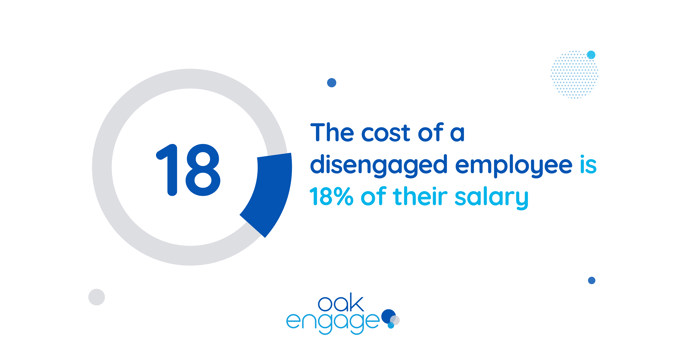
You have to approach the matter of employee engagement with caution. According to Gallups 2022 'The State of Work' report, only 21% of workers are engaged. With such shocking stats at hand, it's becoming more obvious that businesses need place larger emphasis on employee engagement, lest they suffer dire financial consequences.
Don't Add Fuel to The Fire
Thinking that getting rid of employee engagement tools will save money is a big mistake that can actually lead to significant financial losses. When companies ignore these tools, it creates a disengaged workforce that is more likely to leave, resulting in higher recruitment and training costs. Disengaged employees also perform poorly, miss deadlines, and drag down overall company performance. Without employee engagement tools, the positive company culture suffers, causing lower morale, decreased well-being, and weakened teamwork. This, in turn, leads to more absenteeism, increased healthcare expenses, and a toxic work environment.
However, smart companies know that investing in employee engagement tools brings numerous benefits and a competitive edge. Prioritising these tools creates a sense of belonging, open communication, and recognition for employees, leading to improved retention and higher productivity. Engaged employees are motivated, work well together, and deliver better results. They meet deadlines consistently and contribute to a positive work environment. By fostering a supportive company culture through these tools, businesses enhance employee well-being, reduce absenteeism, and cut healthcare costs. In the long run, the financial gains of investing in employee engagement far outweigh the initial expenses, making these tools crucial for long-term success in today's ever-changing business world.
Recommended Reading 📖: Employee Engagement: The Ultimate Guide 2021
Areas Employee Disengagement Can Impact Your Business
Employees are the heart and soul of any business. Naturally, their connection to the business has a significant bearing on the bottom-line . What many businesses grapple with is the ROI of employee engagement strategies and enablers.
How can you focus your strategy on demonstrating the financial benefits? These are the areas of the business impacted by employee engagement and their ROI.
Employee Productivity
A team of engaged employees are proven to be 21% more profitable than teams who aren't. The link between employee engagement and extra productivity is hard to deny.
Based on the findings of the Gallup study, if you have ten engaged teams, you gain the equivalent of another in productivity! By increasing output to this extent you can easily justify investment into employee engagement.
Employee Retention
Employee engagement strategy is vital to keeping hold of your talent. According to Gallup, highly engaged businesses enjoy 59% less turnover. When an employee is disengaged they have far less reason to stay or show any loyalty.
Engaged employees care about their work, as well as being more proactive in finding solutions to problems. They will be motivated beyond their paycheque and there will be less concern about losing talent to another organisation.
The ROI of employee engagement will be demonstrable through its direct impact on turnover and the associated costs.
Employee Turnover
When calculating employee turnover, you must factor in the cost of exit, recruitment cost, replacement cost and lost productivity. Due to its complexity, several estimations exist as to how much turnover actually costs.
However, Centre for American Progress (CAP) found that turnover generally costs:
- 16% of those earning less than $30,000 (£23,000) per annum
- 20% of those earning between $30,000- $49,999 (£37,000) per annum
- Up to 213% of annual salary for executive positions or $50,000+ per annum
These figures will (or at least should) make you sit up and take notice. However, the most engaged teams are found to have 59% less turnover. Cost savings should be considered when weighing up potential ROI.
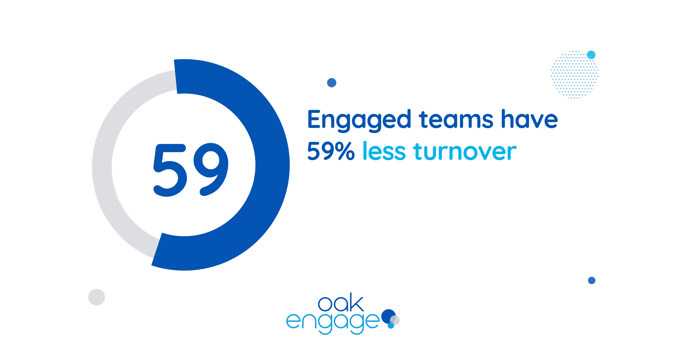
Employee Onboarding
Employees who have a negative onboarding experience are twice as likely to look for other career opportunities. Onboarding is absolutely key to initial engagement. First impressions are important!
Ensure your onboarding process is immersive and informative to increase the possibility of retention.
A Glassdoor study found that an employer spends an average of £3,000 and 27.5 days hiring a new employee. Poor onboarding will increase the regularity of this process.
Good onboarding will get new recruits to grips with the company and role in a timely fashion.
Employee Absenteeism
Absenteeism is when an employee is off work frequently. Several causes of absenteeism are linked to disengagement. Generally, these are work related stress, general disinterest and burnout.
A Workforce Institute study found that absenteeism costs on average 1.2% of employee salary. That’s an extra £3,600 per ten workers on a £30,000 salary. This figure will be considerably higher when disengagement is endemic in an organisation.
Mitigating disengagement will help to save money from lost days, output and stress related illness. It is reported that engaged workforces enjoy 41% less absenteeism.
Customer Satisfaction
A Gallup report found that engaged teams have 10% higher customer ratings. Engaged employees invariably provide a more pleasant customer experience projected by their mood.
This does not only apply to customer facing roles. Quality of products and services developed by engaged teams are all linked to how a consumer feels.
A recent Salesforce study also found that 89% of consumers will make another purchase after a positive customer service experience. The better the customer experience, repeat custom and referrals you get.
How to Calculate ROI On Employee Engagement
Organisations can enhance their approach to measuring and managing employee engagement by incorporating specialised tools like Pulse Surveys into their qualitative employee engagement analysis. The Oak Engage Pulse Survey is a dedicated employee engagement survey platform designed to offer swift, frequent, and real-time insights into employee sentiments and engagement levels.
This survey tool typically comprises a set of succinct and targeted questions that employees can respond to regularly, often on a weekly or monthly basis. Employee engagement is a measure of the emotional and psychological commitment that employees have towards their work and their organisation. It reflects their level of enthusiasm, motivation, and connection to their job and workplace. Calculating employee engagement typically involves a combination of quantitative and qualitative methods.
One common quantitative method is through employee surveys or questionnaires. These surveys often include questions that assess factors such as job satisfaction, sense of purpose, communication, and relationships with colleagues and managers. Responses are then analysed to generate an overall engagement score or index. Additionally, organisations may use key performance indicators (KPIs) like turnover rate, absenteeism, and productivity to gauge employee engagement indirectly.
The Oak Engage Pulse Survey is a dedicated employee engagement survey platform designed to offer swift, frequent, and real-time insights into employee sentiments and engagement levels. This survey tool typically comprises a set of succinct and targeted questions that employees can respond to regularly, often on a weekly or monthly basis.
The data collected through these surveys is typically presented in user-friendly dashboards or reports, facilitating easier tracking of changes in engagement over time by managers and HR teams. By leveraging tools like the Oak Engage Pulse Survey, organisations can gain a more dynamic and responsive understanding of employee engagement. This, in turn, is critical for making timely adjustments that enhance workplace satisfaction and boost overall productivity. The combination of traditional and specialised survey methods provides a comprehensive perspective on employee engagement, aiding organisations in creating a more positive and engaging work environment.
Benefits of Having Engaged Employees
Engagement (or more specifically a lack of) affects every area of your business. With better employee engagement comes many additional benefits.
Here are the top benefits linked to engaged employees:
Employee Advocacy
Engaged employees not only take pride in their work but also who they work for. They are likely to become brand advocates themselves.
Those who advocate the company will talk about the business in a positive light to people they know. This reflects how the reputation of a business internally can impact how it is projected externally.
What is important here is that brand and vision are communicated clearly by the business, so there is no confusion over the message.
Increased Profits
The higher output from engagement will naturally lead to higher revenue. A Gallup study found that engaged employees result in a 23% increase in profitability. When employees want the business to succeed, they will work towards making the business better.
It goes to show that if you invest your time and resources wisely into employee engagement you will see significant ROI in the bottom-line of your business. ROI on employee engagement is tangible - you just need the right tools to make the decision.
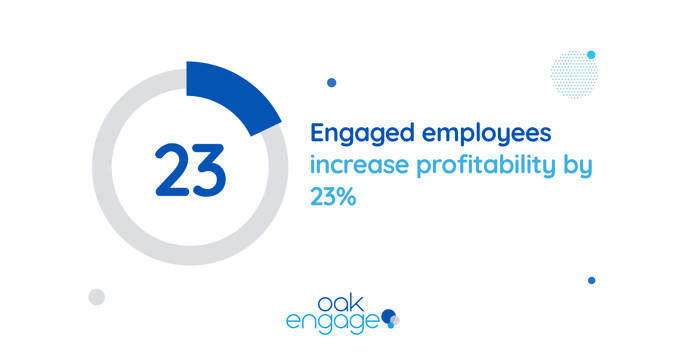
Happy Employees
Although happiness and engagement are not necessarily the same, engagement can lead to happiness.
This is the human aspect to engagement. Helping your workers be happier in their lives is something a business should aspire to do, regardless of their return from it.
That being said, happier workers are still more productive than those who aren't. A study by Oxford University found that happy employees are 13% more productive.
Significantly Fewer Sick Days Taken
Thriving employees miss 53% less days as a result of health related issues. Disengaged workers are generally more stressed. This causes anxiety, depression and a host of other mental and physical illnesses.
As a result of the stress felt by employees and subsequent illness, days will be lost. Output will suffer through absences and will have a direct impact on the bottom line of the business.
Take that stress away and you will notice a marked difference in the number of sick days.
More Employee Participation
Do you yearn for your workers to get involved in discussions and meetings more often? Effective employee engagement can help you achieve this.
Engaged employees reduce absenteeism at work by 41%, resulting in better collaboration and more aligned workers. Given their familiarity with the business, they can offer some of the best suggestions to take it forward.
Creative ideas can come from all types of personnel and offer innovative solutions. But that comes from them having the confidence to speak their mind.
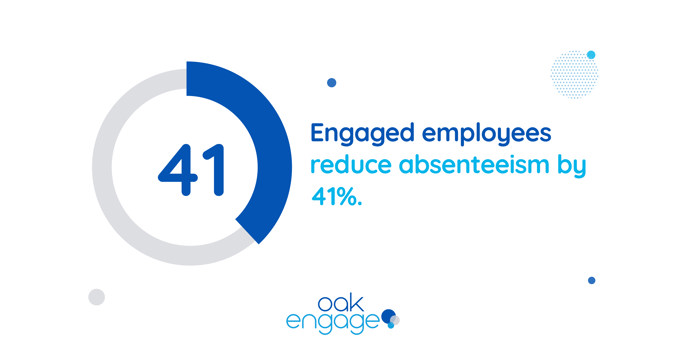
Employee Engagement ROI Calculator
Our Employee Engagement ROI Calculator is designed to quantify the financial impact of disengaged employees in your business.
This will show the true cost of disengaged employees based upon average salaries and size of the workforce.
Please note that figures are based on research carried out by Gallup around the subject of employee engagement. Figures are estimates only.
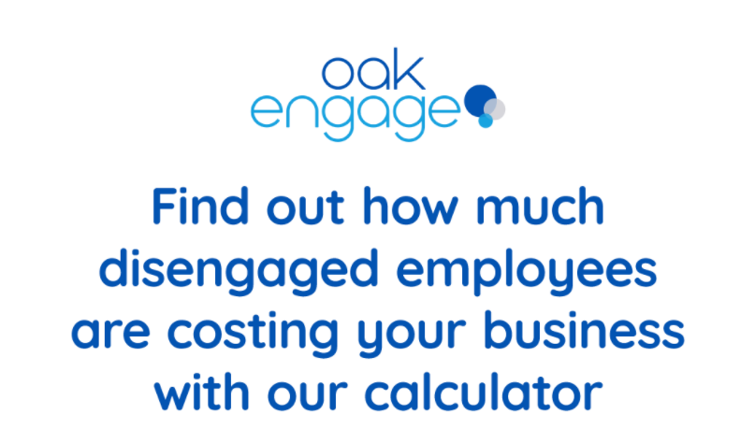
Remember, these results are informed by established research findings and are not subject to our own calculations. If you want to find out the benefits of employee ROI for your business, download your own calculator now.
Oak Engage - Tried, Tested, Favoured

We're employee engagement experts. Our employee engagement app has been engineered to skyrocket engagement levels, connect businesses and facilitate smooth communication between employees and their employer. We offer a range of tools and features that help communicators boost engagement and foster a positive company culture.
Connect: Bridge the gap for deskless employees with the Oak employee engagement app, connecting them to colleagues for better social and working relationships. The app offers a searchable people directory, socializing tools, and collaboration features, enhancing connectivity and creating an engaging experience.
Recognise: Ensure deskless and field employees feel valued with employee recognition integrated into the mobile app. By highlighting good work across the organization, regardless of location, you can cultivate a positive culture. Optimize mobile landing pages to prioritize recognition, news feeds, payslips, and rotas, making it a focal point.
Listen: Empower deskless workers to contribute and communicate with their colleagues through Oak's employee engagement app. Even without a company device, they can join the conversation using QR codes, integrated social and feedback tools. Gain valuable insights through analytics, allowing you to measure and view feedback from previously hard-to-reach employees.
Support: Keep all workers informed with mobile-friendly communications. Employees can securely access essential documents, rotas, payslips, and receive communications through their mobile, even without a company device. The Oak Engage app ensures deskless workers receive critical updates instantly, engage with content, and communicate with each other effectively.
If you'd like to find out how a tool like Oak Engage can help provide an effective ROI for your intranet get in touch today for a quick demo.
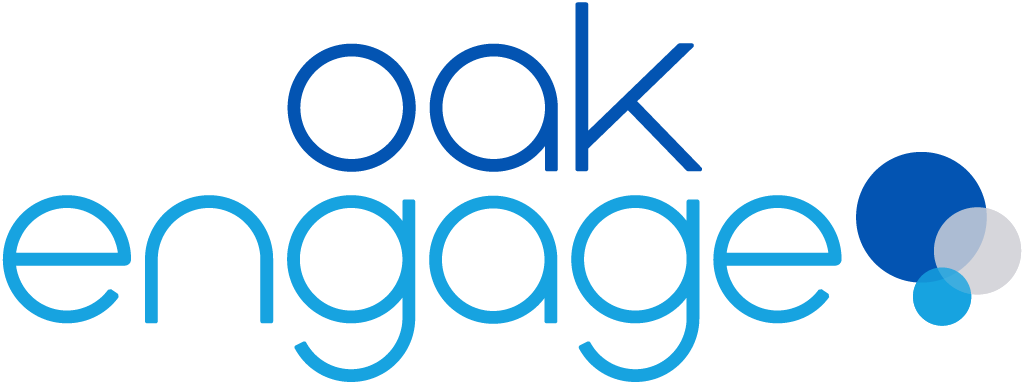

![Disengaged Employees - The Real Cost [FREE ROI Calculator Below]](/media/pudkgven/disengaged-employee-calculator-graphic.jpg?width=50)

